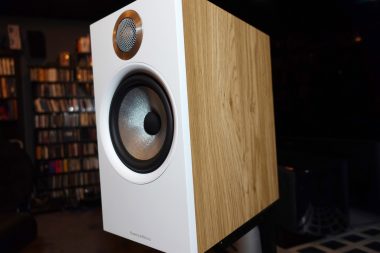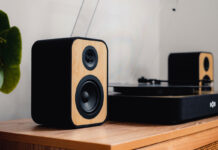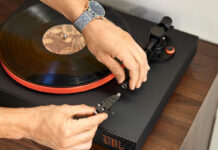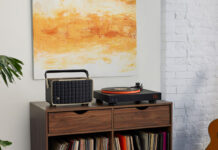 Since the 1960s, the Bowers and Wilkins company out of Southern England has been at the forefront of loudspeaker design and manufacturing, pioneering the use of exotic materials and reliable designs that have made them the centrepiece of discreet listening rooms and music studios alike. Their latest version of popular mid-range 600-series is the Bowers & Wilkins 606 S2 Anniversary bookshelf speakers. They pack a powerful punch in a bookshelf-sized cabinet, living up the legacy of this storied company.
Since the 1960s, the Bowers and Wilkins company out of Southern England has been at the forefront of loudspeaker design and manufacturing, pioneering the use of exotic materials and reliable designs that have made them the centrepiece of discreet listening rooms and music studios alike. Their latest version of popular mid-range 600-series is the Bowers & Wilkins 606 S2 Anniversary bookshelf speakers. They pack a powerful punch in a bookshelf-sized cabinet, living up the legacy of this storied company.
The B&W 600 series has been providing affordable but highly musical speakers in a line that’s within reach for most audiophiles. Here is my look at the Bowers & Wilkins 606 S2 Anniversary bookshelf speakers.
Features of Bowers & Wilkins 606 S2 anniversary bookshelf speakers
The Bowers & Wilkins 606 S2 Anniversary speakers are 19 cm (7.48 in) wide, 34.5 (13.58 in) cm high, and have a depth of 30 (11.81 in) cm. They weigh 13.8 kg (30.5 lb).
- Pair of 30W-200W speakers that deliver powerful sound
- Two-way speakers reproduce full range of audible frequencies for higher depth
- 1″ decoupled double dome tweeter with breakup threshold of 38kHz to highlight layers of your favourite music
- 6.5″ continuum cone for fun and dynamic audio
- Upgraded design with carefully selected components
Achieving the B&W sound
 The Bowers & Wilkins 600-series benefits from shared technological developments and the company design philosophy that also shapes their 700 and top-of-line 800 series. This reflects the “house sound” of the business that emphasizes accurate reproduction over boosting certain frequencies to overly colour the sound, and while they’re now operating under new ownership, the B&W brand has remained consistently committed to the reproduction of musical detail with negligible messing with the mix.
The Bowers & Wilkins 600-series benefits from shared technological developments and the company design philosophy that also shapes their 700 and top-of-line 800 series. This reflects the “house sound” of the business that emphasizes accurate reproduction over boosting certain frequencies to overly colour the sound, and while they’re now operating under new ownership, the B&W brand has remained consistently committed to the reproduction of musical detail with negligible messing with the mix.
Every audio component, from your receiver to your headphones or speakers are voiced in specific ways. Choices about crossover design, the method of speaker construction and even the cabinet geometry all contribute to “tune” the sound in certain ways. For some the B&W house sound is too “analytical” (I’d say accurate to the source!), and it’s exactly that accuracy of doing its best to reproduce what’s on the source without too much fussing around (boosting the bass, say, or over emphasizing the highs) that was the reason I chose a full B&W setup for my own critical listening room.
Hearing the 606 S2s in concert with some of its bigger cousins was quite revealing, as, frankly, the speakers are quite revealing! The fact is that with the 606 S2s you’re going to fall deeper in love with some of your favourite tracks, while being able to more readily hear the difference between a truly solid recording and one that’s overly processed. This is of course a double edged sword, as when you can hear clearly you can clear hear problems as well, meaning you’ll likely want to upgrade some of your recordings, or start chasing better source equipment to pair with them. The overall advantage is that you can use these speakers for years to come as the basis for any serious system or one that you will be growing over time.
Careful construction
 The 606 S2s are two-way speakers, with a mid-range driver borrowing technology from their 800 series speakers, and an aluminum dome tweeter that’s inset into the 345mm high, 190mm wide, 300mm deep cabinet. Sold as a pair, the speaker is available in black, white and oak finish, and they weigh a solid 6.9kg. The dimpled back port is another B&W design that draws from the higher-end series, and foam plugs are included for those that wish to close off the ports for placing directly against a wall. The manufacturer recommends a 30W to 120W amplifier to drive them, and the rear connectors are solidly constructed, allowing with removal of a small plastic cap to use banana plugs and for the truly ambitions to remove a jumper to accommodate bi-wiring. [is this now redundant?]
The 606 S2s are two-way speakers, with a mid-range driver borrowing technology from their 800 series speakers, and an aluminum dome tweeter that’s inset into the 345mm high, 190mm wide, 300mm deep cabinet. Sold as a pair, the speaker is available in black, white and oak finish, and they weigh a solid 6.9kg. The dimpled back port is another B&W design that draws from the higher-end series, and foam plugs are included for those that wish to close off the ports for placing directly against a wall. The manufacturer recommends a 30W to 120W amplifier to drive them, and the rear connectors are solidly constructed, allowing with removal of a small plastic cap to use banana plugs and for the truly ambitions to remove a jumper to accommodate bi-wiring. [is this now redundant?]
Sound and placement
While this size of enclosure is traditionally referred to as a “bookshelf” speaker, I found the 606 S2 benefited far more from having room to breathe when mounted on stands and placed at least a meter away from both the back wall and side walls. Interestingly, right out of the box I found them a bit underwhelming, but after a few hours of operation the mechanical efficiency of the drivers came into their own, and the soundstage opened up significantly.
 While the 606 S2 would also benefit from a small subwoofer even for stereo music playback, they do have quite a bit of musical heft in the low range. Certainly for vinyl playback they do a very reasonably job with bass without ever feeling bloated or over driven, a tribute to the Continuum cone construction, a trademarked woven material that, like B&W’s previous choice with Kevlar, provides a strong but responsible material for the complex movement of a mid-range driver. The aluminum twitter was rarely harsh or brittle, and the crossover between the two seemed to deftly represent the intention of what I threw at it without complaint.
While the 606 S2 would also benefit from a small subwoofer even for stereo music playback, they do have quite a bit of musical heft in the low range. Certainly for vinyl playback they do a very reasonably job with bass without ever feeling bloated or over driven, a tribute to the Continuum cone construction, a trademarked woven material that, like B&W’s previous choice with Kevlar, provides a strong but responsible material for the complex movement of a mid-range driver. The aluminum twitter was rarely harsh or brittle, and the crossover between the two seemed to deftly represent the intention of what I threw at it without complaint.
Giving the 606 S2s a musical workout
Setting up the 606 S2 in my open concept kitchen, hooked into a vintage receiver and playing back Spotify tracks, was underwhelming at first. Without a wall for the rear port to bounce off they sounded a bit thin and uninvolving.
Moving to my main music room, and hooked up to a pair of 300W monoblocks that were obviously more powerful than required for this model, the speakers nonetheless took on the increased signal without complaint. I chose an eclectic mix of music to throw at them, from streaming the latest Taylor Swift tracks to some Classical MP3s, just to see how compressed music worked and whether you could truly hear the difference from more robust sources.
I found it best to slightly toe-in the speakers to the listening position. By angling them right at the listener, and creating an equal-distance, equilateral triangle between where I sat and where they stood, I found the imaging to be quite excellent. Listening to The Beatles’ Rubber Soul in mono had the soundstage appropriately locked between the physical speakers, allowing for the subtleties of that mix to be experienced without ever feeling it was merely two speakers, but rather one sound source located straight in front of you.
I threw on the Cisco pressing of Steely Dan’s Aja just to show that mid-70s height of production, and the 606 S2s did as good a job as expected with a record that, frankly, can sound terrific on just about anything.
My go-to challenge disc is actually the Rolling Stones’ Let It Bleed, with the choir, French Horn and Mick Jagger’s vocal at the start of “You Can’t Always Get What You Want” my ideal track for testing out how the speakers handle that vital crossover between the rich mid-range frequencies and the more piercing high-frequency information. The 606 S2 did a fine job in bring that record to life, and even gave a dose of the same wide-soundstage that the more robust speakers in the B&W line can provide. Aretha Franklin’s Amazing Grace showcased the ambience of the location recording, and a taught production like Miles Davis’ On The Corner showed off the speaker’s ability to quickly and accurately reproduced challenging sounds from distorted trumpets to tuned acoustic drums.
Putting on the Beastie Boys’ Paul’s Boutique was another challenge that the 606 S2s did well with, providing the right dose of clarity and punch even when the modular synth line of “Shake Your Rump” proved some of the lower-extension limitations of these smaller cabinets. Still, there was no rattling or crunchiness to the sound, and for anyone but the most die-hard bass head they’ll be pleased with what these smaller speakers can accomplish.
The final track
When given the right source and space the B&W 606 S2 absolutely shine, but beware that they will expose the limitations in your sources and system. They definitely open up only at higher volume, and when played quietly lack much of what makes them shine against their competitors. These are speakers designed for critical listening, not background noise, so be prepared to turn it up a bit for things to really shine. I found that when mounted on a side-table that they lacked quite a bit of definition as well, and they really do benefit from a pair of stands that will given them the space required and the specific placement to make the most of their technology.
For those willing to commit to speakers of this caliber it’s extremely easy to recommend the 606 S2 Anniversary edition. They help celebrate B&W’s remarkable legacy, and for many will be the highlight of their evolving systems for years to come. For those that wish to get their ears attuned to the B&W house sound these are equally an excellent stepping stone into a whole world of high-fidelity, so a warning: once you’ve heard cabinets of this quality, it won’t be easy to go back to run-of-the mill products far more interested in boom and blast than in the never-ending quest from B&W to make speakers that are both accurate and highly musical.




Pair of 30W-200W speakers that deliver powerful sound – No.
The max watt for 606S2 is 120W. Your info may be from 603S2.
“I found that when mounted on a side-table that they lacked quite a bit of definition as well, and they really do benefit from a pair of stands”
When placing bookshelf speakers on a table top (side-Table), it’s best to have the front edge of the speakers, protrude at least 1/2 inch from the edge of the table, to allow the speaker to “Breathe” in the room, just as speaker stands would allow.
As bookshelf speakers, they can also be placed on their sides, with tweeters on the outside, in order to extend dispersion characteristics and provide for a wider sound stage, in a confined space.
With many of today’s surround sound receivers, these speakers can easily be bi-amplified, which will bring their best foot forward, and maximize their performance.
Comments are closed.